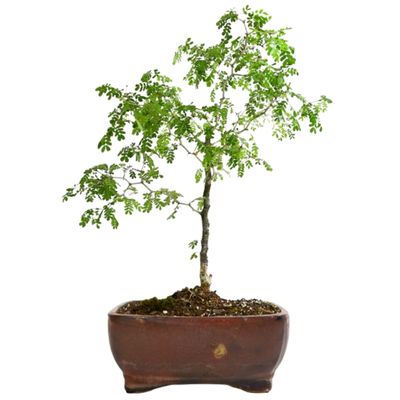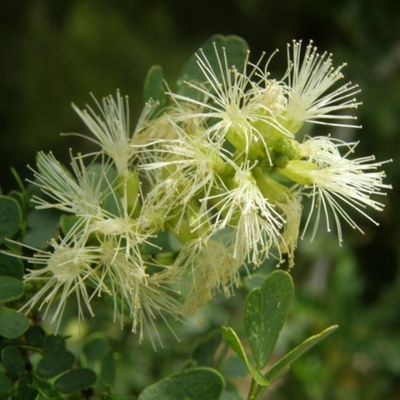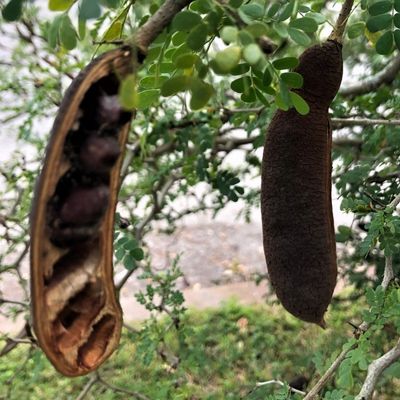
Texas Ebony
(Ebenopsis ebano)
Country of Origin : United States
Bonsai Styles : All the bonsai styles. Except cascade
Zone : 8 – 11
Texas ebony tree ( earlier formally called as Pithecellobium flexicaule, but now it is Ebenopsis ebano) is a slow grower. Because of this reason, Texas ebony is a good choice for small bonsai (shohin) or midsize bonsai (chuhin).
The tree has tiny evergreen compound leaves which are about 2 inches in length. During the night and early morning, the leaves of the tree fold central leaf stalk.
Texas ebony bonsai produces beautiful ‘Puffs-like’ flower spikes and persistent woody seedpods when it is placed outdoors. However, when grown as an indoor bonsai tree, these are rarely formed.
In areas of the trunk that are older, the bark appears grey-brown with some fissures and a rough surface.
Despite its natural tendency to do well in hot, dry climates, the tree has adapted to drop its leaves in times of drought and grow them back when water becomes available again after the drought has ended.
The branches of this plant grow in a distinctive zig-zag pattern. There are spines hidden under the foliage that need to be watched out for.
Because it is highly tolerant to indoor climate, it makes for an excellent indoor bonsai tree.
Hard and resistant, Texas Ebony wood is quite durable. Hence it is much suited for jin or deadwood designs.
The tree is suitable for all bonsai styles, except for cascade style as the wood of the tree is pretty hard.

When the bonsai is kept outdoors, it will produce flowers in late winter and early spring.

Texas ebony tree seedpods
These seedpods are NOT produced when the tree is grown indoors.
Best location to keep Texas Ebony Bonsai
Texas ebony bonsai tree can grow in full sun as well as partial shade of a house.
Remember, the more light it receives, the better the growth of the bonsai tree.
When placing it indoors, keep it in a south or west facing window or windowsill.
One of the things which makes this tree a great choice for indoor bonsai is its nature of thriving in typical home temperatures: – 70°F to 80°F (21°C to 26°C).
If such temperatures are maintained throughout the year, the tree won’t even become dormant or need a resting period.
This tree is very hardy and can tolerate temperatures as low as 30°F (-1°C). But prolonged exposure to such temperatures will lead to the tree dropping its leaves.
You do not need to worry at this point, as the tree will regrow its leaves when the temperature becomes warmer again.
IMP: Refer sunlight requirements for indoor plants for more indoor gardening ideas. Also, refer to do bonsai trees need sunlight for more indoor and outdoor bonsai location ideas.
Propagation of Texas Ebony
Texas ebony plant can be propagated easily by stem cuttings and seeds.
Scrape and nick the outer shell of the seed. Soak the seeds in water for about 24 hours and then sow the seeds. Keep the soil moist. The germination can take up-to 2 months.
If trying to grow it by using stem cuttings, take the stem cutting from semi hard wood stem. Using fully hardwood stems is not advisable as it is harder for them to root.
Apply some rooting hormone to the stem, plant it in soil and water.
Watering Texas Ebony Bonsai
Let the soil dry out a little to the touch in between watering sessions.
Do not over water the bonsai soil and do not keep the soil moist at all times.
If the soil is too wet, then the roots may rot, and the leaves may yellow or even drop from the plant. It is possible, in severe cases, for entire branches to die.
As stated earlier, this tree is fairly drought resistant. One of the signs that the tree needs more water is that the tree will start loosing its leaves.
Read watering bonsai tree for more details.
Wiring Texas Ebony Bonsai
Make sure to start wiring the twigs while they are still soft, and be careful to avoid the spines if possible.
You can even prune the spikes if you wish to. Or use gloves.
As soon as branches harden off, it becomes much more difficult to bend them into the desired shape.
Instead of wire training the mature branches, it is recommended to use pruning techniques to give the tree the desired shape.
Pruning Texas Ebony Bonsai
When to prune Texas Ebony bonsai?
How to prune Texas Ebony bonsai?
If you want to create a smooth and graceful line from your new growth, clip back each branchlet to a set of leaves that are pointing in the direction in which you wish to create new branches.
In the early stages of development, wiring is recommended. However, the ‘clip-and-grow‘ pruning method is best for shaping mature specimens as the branches of this tree grow in a zigzag pattern.
It is possible to create a very natural-looking bonsai style through imaginative pruning.
Pinching of Texas ebony bonsai tree is not necessary because the leaves are quite small.
Repotting Texas Ebony Bonsai
When to repot Texas Ebony bonsai?
Texas ebony bonsai tree can be repotted every 3-4 years as they are slow growers.
Preferred time for repotting is early summer or late spring.
Multiple layers of root can be found on the tree trunk. A radial root pattern can be achieved by retaining the best roots and pruning the rest.
You can also remove air roots or elevated roots in case you see better root system below it.
You can use a basic free-draining bonsai soil mix as a potting soil.
Must Read: Bonsai Soil Recipes
Must read : Choosing the right bonsai container
Feeding Texas Ebony Bonsai
A well-balanced fertilizer at half strength should be applied weekly during active growth.
As long as temperatures remain above 55°F (12°C) in fall and winter, fertilize every two to three weeks.
Read more about bonsai fertilizer and its application.
Diseases and pest of Texas Ebony Bonsai
Texas ebony bonsai tree can suffer from root rot and scale insects.
The seedpods of the tree attract pest. However, the pods can be removed or if the tree is indoor, it is very rare that it will produce any pods.
Scales can be removed manually, or by water jet. or use a systemic insecticide. Use few drops soapy water in the insecticide. The soapy water will help the insecticide to penetrate the outer shell of pests.
Texas Ebony bonsai care
Don’t assume that this is a small tree, it just grows slow.
Young plants can be supplied with little extra water to assist them in growth.
In indoor settings, the trunk will thicken slowly. In case you are planning to have a bonsai with thicker trunk, buy it from a bonsai nursery.
Deadwood can last for years if it is kept dry and lime sulfured.

